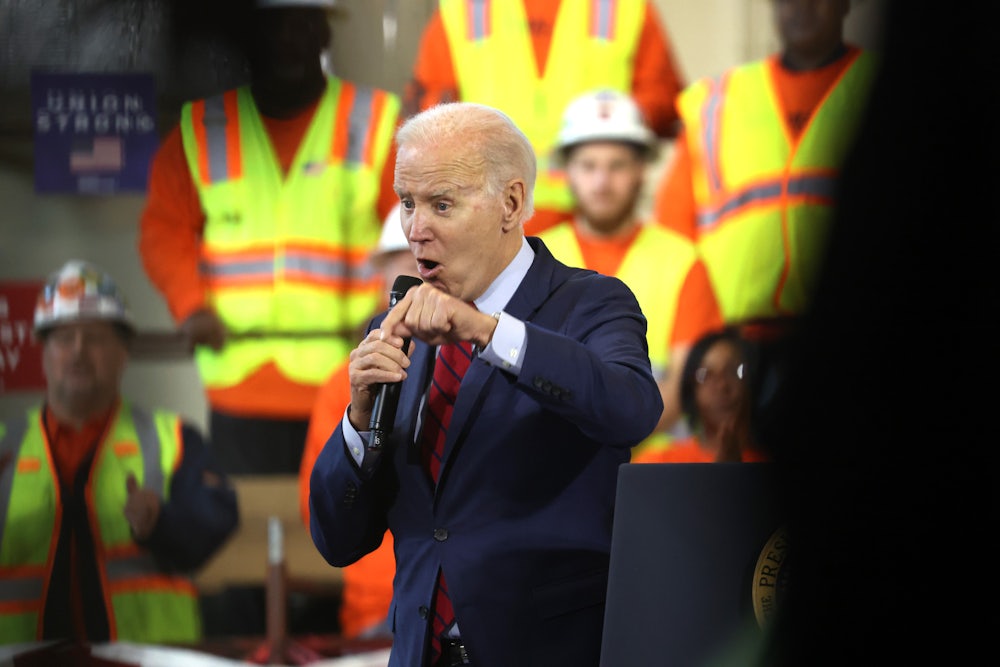It’s early, but the indicators suggest that the 2024 presidential race will once again come down to Joe Biden versus Donald Trump. Biden’s approval numbers may be lagging, and people may think he’s too old. But still, there’s plenty for Democrats to like about such a matchup. There’s no sign that Trump’s legal woes will go away or get better anytime soon, if ever. Trump is still wildly unpopular, and as attention shifts to the presidential election, voters will remember how exhausting he can be.
All of which leaves Democrats generally feeling pretty good about their odds. At the same time, there’s that lingering fact that had about 43,000 votes in three states gone differently, Biden would not have won in 2020. That, and the fact that head-to-head polls remain unnervingly close, leaves little room for error in 2024. So TNR interviewed over a dozen Democratic strategists, and a few Republican ones, to ask: With the race so close and the stakes so high, which state that Biden won in 2020 should Democrats now be most worried about losing in 2024?
Is it Arizona, which Biden won by 10,500 and no Democrat had carried since 1996? Or Georgia, which Biden won by 12,000 votes and no Democrat had carried since 1992?
Somewhat surprisingly, it was neither of those. The rough consensus was that Wisconsin, with its 10 electoral votes and unpredictable elections, is the appropriate source of Democratic hand-wringing going into 2024. This may be a state that elected Senator Tammy Baldwin and Governor Tony Evers, but it’s also the state that sent Scott Walker to the governor’s mansion multiple times (including in his recall election) and returned Ron Johnson to the U.S. Senate. And even as Democrats have built one of the most robust state party operations anywhere in the country, led by party Chairman Ben Wikler, strategists are under no illusion that any big statewide race in Wisconsin is a cakewalk for Democrats.
“The trend has been, in white, non-college-educated rural areas, ever-increasing success for Republican candidates,” explained Democratic strategist Thomas Bowen. “The entire state just doesn’t have dynamic growth—like Georgia, for example—with college-educated young people. Wisconsin is not one of those states that [are] just adding so many new people that Democrats can turn out or convert to their side. So you have to really rely on winning those independent voters who look a lot more like Republican voters than some of the independent voters in other states. And look, Joe Biden won by 20,000 votes. It was really close. And there’s no evidence in national polling so far that a 2020 rematch between Biden and Trump would be anything but close.”
On Georgia, Bowen pointed to Democratic Senator Raphael Warnock’s 2022 runoff election against Republican Herschel Walker as an example of the growing Democratic coalition in the state. “Runoff races typically give an advantage to Republican candidates in the past—those low-turnout elections. Democrats have a hard time getting their coalition out. Well, Democrats get their coalition out in these races, and also their coalition is bigger. So that’s the trendline that’s very helpful in Georgia. I think in Arizona there’s also evidence of the same trendline.”
Pollster Anna Greenberg emphasized the Badger State’s lack of a large Black vote as putting it in a demographically dicier category for Democrats than Georgia. “I think the states where Biden and Democrats have done best since 2018, in part as a reaction to Trump being elected, are states that have big suburban populations, plus a big minority population, especially if it’s a Black minority population. That’s why places like Georgia and Arizona—even though it’s Hispanic voters, but Hispanic voters [in Arizona] are more Democratic than, say Florida or Texas or wherever,” Greenberg said, “are the states that I feel very good about maintaining.” Wisconsin, she said, “does not have big suburban populations. It has a relatively small minority population.”
Others pointed to Wisconsin’s vital importance on the electoral map. “What makes Wisconsin a perpetually tipping-point state, and therefore worrisome, is because it’s vital to the pathway for either Trump or Biden,” said Dan Kanninen, who served as Barack Obama’s 2008 Wisconsin state director. “A lot of the attributes in Wisconsin … you have in other upper-Midwest states. But you have a lower percentage of college-educated white voters as compared to Minnesota, for example. You have more counties and geography in that state that were the traditionally blue-collar, even rural Democratic voters for a long time. Like the [former Congressman] Dave Obey district, which was the quintessential Obama-to-Trump counties. There’s more of those counties in that state than [in] other places. And you have some traditionally conservative strongholds like in Waukesha County, famously. For all kinds of reasons it’s just competitive.”
It’s somewhat of a counterintuitive concern. Democrats, after all, just recently won a major state Supreme Court race that tipped the panel to a liberal majority for the first time in years. But, argued Andrew Drechsler, who runs the Democratic data analytics firm HaystaqDNA, some of the factors of that win won’t necessarily repeat themselves in 2024. Drechsler argued that in that race, Democrats’ preferred judicial candidate, Janet Protasiewicz, benefited from how bad her very conservative opponent was and how abortion was top of mind for voters. Her victory over Dan Kelly might not be easily replicated in the near future.
“The fact that [Kelly] lost by 10-plus points, you have to go back a couple [of] decades to see either a Democrat or a Republican win by that much” in a Senate race or presidential race in Wisconsin, Drechsler said. “In 2022 you had the Democratic governor win with a little bit bigger margin than what Ron Johnson won by.… He only won by 20,000 votes.”
Looking to 2024, Drechsler said, he thinks Biden’s fate may be partly tied to whom the GOP nominates to take on incumbent Democratic Senator Tammy Baldwin. “If Republicans put up one of the more moderate candidates against Baldwin that’s going to be a super tight race,” he said. “There’s going to be a lot of money jumped into it.”
Republicans still have to go through a primary contest to pick their nominee to face Baldwin. The strategists interviewed for this story argued 2024 Senate races between incumbent Democratic senators, like Baldwin, will likely further boost turnout among their base voters. There are no GOP candidates yet, but no one sees a cakewalk: The Cook Political Report and Larry Sabato’s Crystal Ball rate the race “Lean Democratic,” and Inside Elections has it as “Battleground Democratic.”
Perhaps offsetting this anxiety is a general optimism about North Carolina. The state has a Democratic governor, but it also has two Republican senators and a history of always backing the Republican nominee in every presidential election except once (2008) since 1976. Even so, said Democratic strategist Jenn Ridder, “I definitely think North Carolina’s on the map.” Ridder added that Biden has “more appeal to a moderate white voter” than recent Democratic Senate nominees in the state: “So I think that’s why. He just has a little bit broader appeal. And if we can adequately turn out the Black vote there, we can win.” Trump won the Tarheel State by just 1 percent last time.
On North Carolina, Greenberg said it “feels like one that’s on the cusp. It’s got a big suburban college-educated population. It’s got a significant minority population, and Biden barely lost it. It’s going to have a competitive gubernatorial race, which will obviously help.”
Democratic hand-wringing about their electoral prospects usually only happens on days that end in y. The difference here is that there is a conscious worry across the party about a state that is a consistent battleground—one that Democrats have overlooked or taken for granted in the past to their detriment, as in 2016. It’s easy to look at Protasiewicz’s win and the 2020 election results and put Wisconsin in the lean-Biden column. But that overlooks just how swingy the state actually has been and continues to be.
“Wisconsin remains perched on a knife’s edge,” Wisconsin Democratic Party Chairman Ben Wikler told me. “As you can see from the location of their first presidential primary debate and their national convention, the GOP is obsessed with flipping Wisconsin. Democrats will prevail in Wisconsin not because victory is inevitable but because they’ll work constantly, for the next 19 months, to persuade and organize voters in every single community in the Badger State.”
Wikler has a history of delivering—and for Biden to stay in office, he’ll have to do it again.






